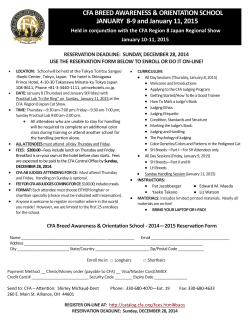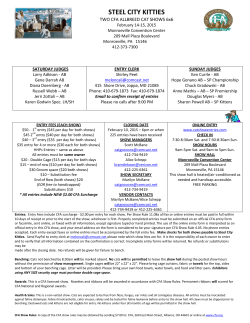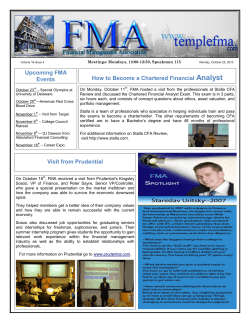
CHAPTER 6 UNDERSTANDING CASH FLOW STATEMENTS Presenter’s name Presenter’s title
CHAPTER 6 UNDERSTANDING CASH FLOW STATEMENTS Presenter’s name Presenter’s title dd Month yyyy OVERVIEW • Statement of Cash Flows: Overview • Format of Statement of Cash Flows • Preparing a Statement of Cash Flows • Additional Analytical Considerations Copyright © 2013 CFA Institute 2 Copyright © 2013 CFA Institute 3 APPLE, Inc. Copyright © 2013 CFA Institute 4 CLASSIFICATION OF ACTIVITIES ON THE STATEMENT OF CASH FLOWS Operating activities: Deliver or produce goods for sale and provide services. Examples: • Receive cash from customers • Pay cash to suppliers • Pay cash for operating expenses. Investing activities: Buy or sell long-term assets and other investments. Examples: • Property, plant, and equipment (PP&E) • Other companies’ securities (that are not cash equivalents) Financing activities: Obtain or repay capital. Examples: • Borrow from creditors and repay the principal • Issue or repurchase stock • Pay dividends Copyright © 2013 CFA Institute 5 COLGATE: CASH FLOWS CLASSIFIED BY ACTIVITY 2011 Net cash provided by operations 2010 2009 2,896 3,211 3,277 Net cash used in investing activities (1,213) (658) (841) Net cash used in financing activities Effect of exchange rate changes Net (decrease) increase in cash and cash equivalents (1,242) (53) (2,624) (39) (2,270) (121) 388 (110) 45 490 $878 600 $490 555 $600 Cash and cash equivalents at beginning of year Cash and cash equivalents at end of year Copyright © 2013 CFA Institute 6 COLGATE’S OPERATING CASH FLOWS Copyright © 2013 CFA Institute 7 COLGATE’S INVESTING CASH FLOWS Copyright © 2013 CFA Institute 8 COLGATE’S FINANCING CASH FLOWS Copyright © 2013 CFA Institute 9 COMMON-SIZE STATEMENT OF CASH FLOW FOR COLGATE (ABBREVIATED) Each line item is presented as a percentage of net revenue. 2011 Operating Activities Net income including noncontrolling interests Net cash provided by operations Net cash used in investing activities Net cash used in financing activities Copyright © 2013 CFA Institute 2010 2009 15.3% 14.9% 15.6% 17.3% 20.6% 21.4% –7.2% –4.2% –5.5% –7.4% –16.9% –14.8% 10 COLGATE’S CASH FLOWS: SUMMARY • Overall, $323 million net increase in cash over three years, from $555 million at the beginning of 2009 to $878 million at the end of 2011. • Colgate consistently obtains its cash inflow from operating activities and uses cash in investing and financing activities—a typical profile for a mature company. • Colgate’s operating cash flow exceeded net income in every year—a desirable profile for a mature company. • In every year, Colgate’s cash from operations was more than enough to cover its capital expenditures. • The amount of dividends paid has steadily increased over the past three years. • Amount of operating cash after paying for capital expenditures was more than enough to cover the dividend payments. • In summary, Colgate’s cash flows represent a positive profile. Copyright © 2013 CFA Institute 11 COLGATE’S OPERATING CASH FLOWS: INDIRECT METHOD Copyright © 2013 CFA Institute 12 INDIRECT VS. DIRECT METHOD FOR PRESENTING OPERATING CASH FLOWS Indirect method • Begins with net income and adjusts to operating cash flows. • Arguments for: - Clearly shows the reasons for differences between net income and operating cash flows. - Mirrors forecasting approach that begins with forecast of income, then derives cash flows. Copyright © 2013 CFA Institute Direct method • Shows each cash inflow and outflow related to receipts and disbursements. • Arguments for: - Provides information on the specific sources of operating cash receipts and payments. - Does not net. 13 INDIRECT VS. DIRECT METHOD FOR PRESENTING OPERATING CASH FLOWS Indirect method • IFRS permit. • U.S. GAAP permit. • Used by the majority of companies, whether reporting under IFRS or U.S. GAAP. Copyright © 2013 CFA Institute Direct method • IFRS encourage. • U.S. GAAP encourage, but requires a reconciliation of net income to cash flow from operating activities. 14 TECH DATA’S OPERATING CASH FLOWS: EXAMPLE OF DIRECT METHOD Copyright © 2013 CFA Institute 15 CLASSIFICATION OF CASH FLOWS UNDER IFRS VS. U.S. GAAP Item Interest received Interest paid Dividends received Dividends paid IFRS Operating or investing Operating or financing Operating or investing Operating or financing Bank overdrafts Considered part of cash Not considered part equivalents of cash and cash equivalents; classified as financing. Generally operating, but Operating a portion can be allocated to investing or financing Taxes paid Copyright © 2013 CFA Institute U.S. GAAP Operating Operating Operating Financing 16 PORTUGAL TELECOM’S OPERATING CASH FLOWS: ANOTHER EXAMPLE OF DIRECT METHOD Copyright © 2013 CFA Institute 17 PORTUGAL TELECOM’S INVESTING CASH FLOWS Copyright © 2013 CFA Institute 18 PORTUGAL TELECOM’S FINANCING CASH FLOWS Copyright © 2013 CFA Institute 19 NONCASH INVESTING AND FINANCING ACTIVITIES • Noncash transaction: Any transaction that does not involve an inflow or outflow of cash (e.g., exchange of one no-monetary asset for another). • Not incorporated in the cash flow statement. • Must be disclosed. Copyright © 2013 CFA Institute 20 Cash at beginning and end of year links to the balance sheet. Copyright © 2013 CFA Institute 21 Cash at beginning and end of year links to the balance sheet. Copyright © 2013 CFA Institute 22 PREPARATION OF THE STATEMENT OF CASH FLOWS: STEPS • Step 1. Determine the change in cash. • Step 2. Determine the net cash flow from operating activities. Use both the current year's income statement and information on current assets and liabilities from the comparative balance sheets. • Step 3. Determine net cash flows from investing and financing activities. Examine all other changes in the balance sheet accounts. • Step 4. Include summary of net increase (decrease) in cash, cash at beginning, and cash at end. • Step 5. Disclose any significant noncash transactions separately at the bottom of the statement. Copyright © 2013 CFA Institute 23 EXAMPLE A new company has the following transactions: • Sells stock for $100. • Buys a building for $50. Its primary line of business is selling a service, so it has no COGS (cost of goods sold) and no inventory. • Makes credit sales of $100, and subsequently collects $90. • Accrues SG&A (selling, general, and administrative) expense of $40, and subsequently pays cash of $25. • Records depreciation expense of $10. Copyright © 2013 CFA Institute 24 STEP 1. DETERMINE THE CHANGE IN CASH This step is straightforward. The information is on the comparative balance sheets. Change was $115. Cash Accounts receivable Building Accumulated depreciation Total assets Accounts payable Common stock Retained earnings Total liabilities and equity Copyright © 2013 CFA Institute Beginning Ending balance balance Change 0 115 115 0 10 10 0 50 50 0 (10) (10) 0 165 165 0 15 15 0 100 100 0 50 50 0 165 165 25 STEP 2. DETERMINE THE NET CASH FLOW FROM OPERATING ACTIVITIES, BEGINNING WITH NET INCOME FOR THE INDIRECT METHOD Income statement Credit sales SG&A expense Depreciation expense Net income Net income + Depreciation expense – Change in receivables + Change in payables Cash from operating activities Copyright © 2013 CFA Institute $ 100 –40 –10 $ 50 $ 50 +10 –10 +15 $ 65 Noncash expense Only collected $90 Only paid $25 26 STEP 3. DETERMINE NET CASH FLOWS FROM INVESTING AND FINANCING ACTIVITIES Examine all other changes in the balance sheet accounts. Beginning Ending balance balance Change Cash 0 115 115 In first step Accounts receivable 0 10 10 In operating Building 0 50 50 ? Accumulated depreciation 0 (10) (10)In operating Total assets 0 165 165 Accounts payable 0 15 15 In operating Common stock 0 100 100 ? Retained earnings 0 50 50 In operating* Total liabilities 0 165 165 *There are no dividends in this example; all changes in retained earnings are from net income Copyright © 2013 CFA Institute 27 INVESTING CASH FLOWS • Determine investing cash flows by examining changes in long-term assets. In this example, we have only PP&E. • Beginning PP&E + Purchases – Dispositions = Ending PP&E • Ending PP&E – Beginning PP&E = Purchases – Dispositions (i.e., investing cash flows) • PP&E increased by $50, indicating cash spent acquiring PP&E. • We also know this from the transaction list at the beginning of the example. Copyright © 2013 CFA Institute 28 FINANCING CASH FLOWS • Determine financing cash flows by examining changes in debt and equity accounts. In this example, we have only common stock. • Beginning stock + Issuances – Repurchases = Ending stock • Ending stock – Beginning stock = Issuances – Repurchases • Stock account increased by $100, indicating cash was raised by issuing stock. • We also know this from the transaction list at the beginning of the example. Copyright © 2013 CFA Institute 29 STEP 3. DETERMINE NET CASH FLOWS FROM INVESTING AND FINANCING ACTIVITIES Examine all other changes in the balance sheet accounts. Beginning Ending balance balance Change Cash 0 115 115 In first step Accounts receivable 0 10 10 In operating Building 0 50 50 In investing Accumulated depreciation 0 (10) (10)In operating Total assets 0 165 165 Accounts payable 0 15 15 In operating Common stock 0 100 100 In financing Retained earnings 0 50 50 In operating* Total liabilities 0 165 165 *There are no dividends in this example, so all change was net income. Copyright © 2013 CFA Institute 30 INDIRECT METHOD Company ABC Cash Flow Statement for the period ended Operating cash flow Net income Depreciation expense Increase in accounts receivable Increase in accrued liabilities Total operating cash flow 50 + 10 – 10 + 15 + 65 Investing cash flow Capital expenditure – 50 Financing cash flow Issue of stock + 100 Total change in cash Beginning cash balance Ending cash balance Copyright © 2013 CFA Institute + 115 0 115 31 ALTERNATIVE STEP 2. DETERMINE THE NET CASH FLOW FROM OPERATING ACTIVITIES, BEGINNING WITH EACH LINE ITEM FOR THE DIRECT METHOD Income statement Credit sales SG&A expense Depreciation expense Net income $ 100 –40 –10 $ 50 Cash from customers $ 90 Cash paid for expenses Cash from operating activities –25 $ 65 Copyright © 2013 CFA Institute Credit sales ($100) minus Change in receivables ($10) SG&A expenses ($40) minus increase in payables ($15) 32 DIRECT METHOD Company ABC Cash Flow Statement for the period ended Cash collected from customers Cash paid to suppliers Total operating cash flow + 90 – 25 + 65 Investing cash flow Capital expenditure – 50 Financing cash flow Issue of stock + 100 Total change in cash Beginning cash balance + 115 0 Ending cash balance Copyright © 2013 CFA Institute 115 33 FREE CASH FLOW Free Cash Flow to the Firm (FCFF): Cash flow available to the company’s suppliers of capital (debt and equity). - After all operating expenses (including taxes) have been paid. - After all operating investments have been made for fixed capital and working capital. Free Cash Flow to Equity (FCFE): Cash flow available to the company’s common stockholders. - After all operating expenses (including taxes) have been paid. - After borrowing costs (principal and interest) have been paid. - After all operating investments have been made for fixed capital and working capital. Copyright © 2013 CFA Institute 34 COMPUTE FCFF Net Income + Noncash charges – Working capital investment + Interest expense × (1 – Tax rate) – Fixed capital investments Interest, a cash flow available to one of the capital providers, which has been deducted from net income, so it must be added back = FCFF Copyright © 2013 CFA Institute 35 FCFF CAN ALSO BE COMPUTED FROM CASH FLOW FROM OPERATING ACTIVITIES Net income + Noncash charges – Working capital investment = Cash from operating activities CFO already has added noncash items to net income and deducted working capital investment + Interest Expense × (1 – Tax rate) – Fixed capital investments = FCFF Copyright © 2013 CFA Institute 36 COMPUTE FCFE Net Income + Noncash charges – Working capital investment – Fixed capital investment + Net new borrowing (or minus net debt repayments) = FCFE Copyright © 2013 CFA Institute Positive FCFE means that the company has an excess of operating cash flow over amounts needed for capital expenditures and repayment of debt. 37 CASH FLOW PERFORMANCE RATIOS Ratio Cash flow to revenue Cash return on assets Cash return on equity Cash to income Cash flow per share Copyright © 2013 CFA Institute Calculation CFO ÷ Net revenue What It Measures Operating cash generated per dollar of revenue CFO ÷ Average total assets Operating cash generated per dollar of asset investment CFO ÷ Average Operating cash generated shareholders’ equity per dollar of owner investment CFO ÷ Operating income Cash generating ability of operations (CFO – Preferred dividends) Operating cash flow on a ÷ Number of common shares per-share basis outstanding 38 CASH FLOW COVERAGE RATIOS Ratio Debt coverage Calculation CFO ÷ Total debt Interest coverage (CFO + Interest paid + Taxes paid) ÷ Interest paid Reinvestment CFO ÷ Cash paid for longterm assets Debt payment CFO ÷ Cash paid for longterm debt repayment CFO ÷ Dividends paid Dividend payment Investing and CFO ÷ Cash outflows for financing investing and financing activities Copyright © 2013 CFA Institute What It Measures Financial risk and financial leverage Ability to meet interest obligations Ability to acquire assets with operating cash flows Ability to pay debts with operating cash flows Ability to pay dividends with operating cash flows Ability to acquire assets, pay debts, and make distributions to owners 39 SUMMARY • The cash flow statement provides information about a company’s cash receipts and cash payments during an accounting period. • Cash flows are categorized as operating, investing, and financing. • Compared with U.S. GAAP, IFRS provide companies with more choices in classifying some cash flow items as operating, investing, or financing activities. • The operating activities section of the statement of cash flows can be presented using the direct method or the indirect method. • Two approaches to developing common-size cash flow statements are the total cash inflows/total cash outflows method and the percentage of net revenues method. • Cash flow ratios measure a company’s profitability, performance, and financial strength. Copyright © 2013 CFA Institute 40
© Copyright 2025









